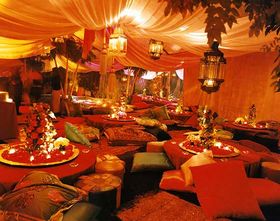The Brass Coast look and feel
Overview
The Freeborn look is one of bright colours, silks, jewels and sumptuousness. They admire ornate or bejewelled items. To the Freeborn, a brilliant craftsman is one who can make something elegant as well as sturdy. Their weapons and armour are often engraved or adorned, but they are not fatuous, and do not compromise utility for the sake of appearance. Jewellery is very common with the best pieces, like necklaces, crowns or tiaras, designed to frame the wearers hands or face.
The image of the flame is central to the Freeborn culture, they believe it represents their spirit; wild, powerful and unchained.
Also see Brass Coast Costumes and Brass Coast Icons and Artistry.
Breakdown
Influences
The traditional looks of Moorish Spain, Morocco, Algeria, Tunisia
Materials
Lightweight fabrics such as voiles and chiffons, either silk or synthetic. Also silks, brocades and other rich fabrics. Leather is considered unappealing for clothing, it’s a heavy material they reserve for boots and armour. Gold is prized over silver where available.
Colours
Bright, vibrant colours, especially the colours of flames: strong bright yellows, brilliant oranges and every conceivable shade of red as well as gold and silver. Expensive clothing is made in brightly coloured layers to convey the impression of the fire within.
Avoid Black or White. Black is considered severe and used for shrouds to wrap the dead. White is the colour of the poor, of those too impoverished to afford exotic dyes.
Clothing
Veils, scarves, head-wraps, pantaloons, loose shirts and kaftans, sashes rather than belts. Clothing is usually worn loose with layers of draped material.
Veils are worn by men and women to make them appear more mysterious and alluring. The ideal style is the tagelmust (preferably in bright red, orange or yellow rather than blue).
Clothing and headdresses will often be decorated with shiny metal jewellery, bells, coins and other jingly bits. Jewelry should frame the hands and face.
Ideally scabbards or pouches should hang at the waist by a silk cord that goes over the shoulder. Any tattoos should be highly intricate, henna-style.
Armour
Scale is the ideal armour, ideally in a bright golden colour. Chain in the “jannissary” style, particularly the chain helmets, is also great. Small pieces of plate or breastplates are also good especially if ornate and inlaid. Leather armour is common, either magnificently tooled or used to hold pieces of metal armour in place.
Armour, whether metal or leather, should have embellished edges and rich decoration, with calligraphy and ornate designs.
Shields
Round (ideally domed) metal shields, highly decorated if possible.
Weapons
Scimitars are less common than straight swords and axes. The Bhuj, a large heavy single-bladed spear, is the ideal pole-arm. The best quality weapons are intricately etched and engraved.
Feel
Free, flowing, headstrong, sumptuous, practical, exuberant, hedonistic, colourful, rich, joyful
Things to Avoid
- Shemagh, keffiyeh (patterned ‘tea towel’ worn on head) and agal.
- Fez and bandanna.
- All “high” turbans such as the classic Islamic or Sikh turban.
- Everything defined as “sartorial hijab” by wikipedia - burqa, niqab, etc.
